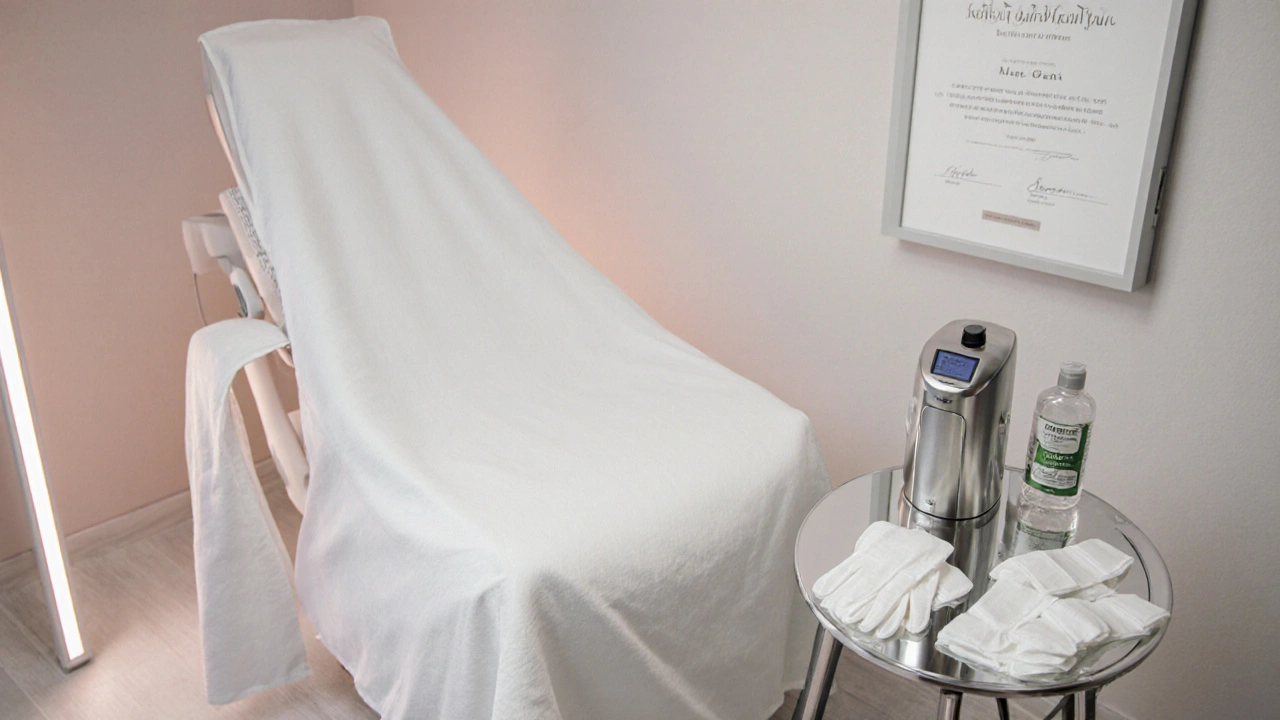Hair Removal Salon Comparison Tool
Rate each salon based on the following criteria from 1 to 5:
Salon 1
Salon 2
Salon 3
Quick Take
- Check the salon’s certifications and staff qualifications before booking.
- Know which hair‑removal method (laser, electrolysis, waxing, etc.) works best for thick, coarse hair.
- Read verified client reviews and request before‑and‑after photos.
- Ask about hygiene practices, equipment age, and post‑treatment care.
- Create a simple scoring sheet to compare at least three salons side‑by‑side.
When hunting for a reliable hair removal salon is a professional service that offers various permanent or semi‑permanent hair reduction techniques, start by checking the basics: licensing, cleanliness, and the type of technology they use. The goal is to find a place that can handle excessive hair without causing skin damage or endless appointments. Below is a step‑by‑step guide that helps you evaluate each salon on the factors that truly matter.
Understanding Excessive Hair and Its Causes
Excessive hair, sometimes called hirsutism, can be genetic, hormonal, or medication‑induced. Menopausal women, people with polycystic ovary syndrome (PCOS), or those taking certain steroids often see thicker, darker growth on the chest, back, or face. Knowing the underlying cause helps you choose the right treatment method because some technologies work better on coarse, dark hair than on fine, light strands.
Key Elements to Look for in a Hair Removal Salon
Focus on the following eight criteria. Each one is backed by industry standards and real‑world client experiences.
- Technician certification is proof that the practitioner has completed accredited training and holds a valid license to operate laser or electrolysis devices. Ask to see their certification card.
- Hygiene standards are the set of cleaning protocols and disposable equipment policies that keep the treatment area free from cross‑contamination. Look for visible cleaning logs or inquire about sterilization methods.
- Equipment age and type is the model year and technology (e.g., diode laser, Nd:YAG, IPL) that determines efficacy on thick hair and safety on various skin tones. Newer machines often have built‑in skin‑type sensors.
- Treatment method is the specific hair‑removal technique such as laser, electrolysis, waxing, or sugaring offered by the salon. Match the method to your hair density.
- Pricing transparency is clear upfront cost per session or a package deal, without hidden fees for follow‑up appointments. Get a written quote.
- Location and accessibility is how easy it is to reach the salon, considering parking, public transport, and operating hours. A convenient spot improves adherence to multi‑session plans.
- Client testimonials and before‑after photos are real evidence of the salon’s results, especially for people with similar hair‑type concerns. Verify that photos are dated.
- After‑care support is post‑treatment guidance, product recommendations, and a clear line of communication for any side‑effects. Good salons provide written after‑care instructions.
Popular Hair‑Removal Techniques and Their Suitability for Excessive Hair
Here’s a quick rundown of the most common methods. Each has pros and cons when dealing with large volumes of coarse hair.
| Method | Effectiveness on Thick Hair | Typical Sessions | Average Cost per Session (USD) | Key Pros | Key Cons |
|---|---|---|---|---|---|
| Laser hair removal | High - targets melanin in coarse strands | 6‑8 | $150‑$250 | Long‑term reduction, suitable for large areas | Requires multiple visits, not ideal for very light hair |
| Electrolysis | Very High - destroys individual follicles | 15‑30 (depends on area) | $75‑$120 | Permanent, works on any hair color | Time‑intensive, can be uncomfortable |
| Waxing | Medium - removes hair from root each session | Every 3‑4 weeks | $30‑$80 | Quick, inexpensive, good for temporary smoothing | Painful, results are short‑term, can cause ingrown hairs |
| Sugaring | Medium - similar to waxing but uses natural sugar paste | Every 3‑4 weeks | $35‑$90 | Less irritation, natural ingredients | Same short‑term nature as waxing, not permanent |

How to Vet a Salon’s Reputation
Online reviews are useful, but dig deeper. Look for patterns: repeated praise for staff professionalism, consistent mention of cleanliness, and transparent pricing. If a salon has a dedicated Dermatology clinic partnership, that's a good sign they stay updated on skin safety.
Ask the salon for references. Real clients should be willing to share their treatment timeline and any side‑effects they experienced. A reputable salon will also have a visible board showing their Technician certification and a clean, organized waiting area that meets health‑code standards.
Consultation Checklist: Questions to Ask Before You Book
- What specific laser or electrolysis device do you use, and when was it last serviced?
- Can I see a copy of the technician’s certification and the salon’s health inspection report?
- How do you determine the number of sessions needed for my hair type and skin tone?
- What is your policy on follow‑up appointments if the first round doesn’t achieve the expected reduction?
- Do you provide a written after‑care plan, and which products do you recommend?
- Is there a satisfaction guarantee or a package discount for multiple areas?
Take notes during the call. A salon that answers clearly and provides documentation is usually trustworthy.
Red Flags: What Should Make You Walk Away?
- No visible licenses or certification displayed.
- Utterly low prices that seem too good to be true - may indicate outdated equipment.
- Staff who can’t explain the difference between laser and IPL or who push a single method without assessing your skin type.
- Unclean treatment rooms, reused wax strips, or no disposable gloves visible.
- Guarantees of “permanent hair‑free skin after one session.” Real results need time.
Scoring Your Options: A Simple Decision Matrix
Put each salon you’ve visited into a spreadsheet. Rate them 1‑5 on the eight criteria listed earlier, then add up the totals. The highest score usually points to the best overall fit. Here’s a quick template you can copy:
- Certification (1‑5)
- Hygiene (1‑5)
- Equipment (1‑5)
- Method suitability (1‑5)
- Pricing clarity (1‑5)
- Location/access (1‑5)
- Reviews/photos (1‑5)
- After‑care (1‑5)
Pick the salon with the highest aggregate score, but also weigh any personal comfort factors - like a friendly receptionist or a relaxing ambiance.
Next Steps After Choosing a Salon
Schedule your initial consultation. Bring a recent photo of the area you want treated, a list of any medications you’re taking, and a brief medical history (especially skin conditions). Ask the technician to perform a patch test if you’re opting for laser or IPL. Follow the after‑care instructions exactly; use gentle cleansers, avoid sun exposure, and apply any recommended soothing gels.
If you notice excessive redness, blistering, or pigment changes, contact the salon immediately. Most reputable places will offer a complimentary follow‑up to address side‑effects.

Frequently Asked Questions
How many laser sessions are needed for thick back hair?
Most people see a 70‑80% reduction after 6‑8 sessions spaced 4‑6 weeks apart. The exact number depends on hair density, skin tone, and the laser’s wavelength.
Is electrolysis painful for large areas like the chest?
Electrolysis uses a fine needle to target each follicle. For big areas it can feel like a series of tiny pinpricks. Numbing creams or topical anesthetics are often offered, and many clients report that the discomfort lessens after the first few sessions.
Can I combine waxing and laser treatments?
Yes, but timing matters. Waxing removes the hair shaft, while laser needs pigment in the follicle. Wait at least two weeks after waxing before your laser session, so the follicle is still intact for the laser to target.
What should I look for in a salon’s hygiene protocol?
Clean, disposable gloves, sterile probe covers for laser or electrolysis devices, and a visible cleaning log are essential. Ask to see a copy of their most recent health‑department inspection.
Do I need a dermatologist’s referral for laser hair removal?
Not usually, unless you have a medical skin condition (e.g., eczema, psoriasis). A reputable salon will perform a skin assessment and may recommend a dermatologist if they see a risk.
Finding the right hair removal salon takes a bit of homework, but the payoff is smooth, confident skin without surprise burns or endless appointments. Use the checklist, compare methods, and trust your instincts - the best salon will respect your time, your skin, and your budget.

luemba leonardo brás kali
September 29, 2025 AT 02:18You've compiled a solid framework for evaluating hair‑removal salons; the eight‑point checklist covers the essentials without overwhelming the reader. The inclusion of a scoring matrix makes the decision process tangible and data‑driven.
Corey McGhie
October 15, 2025 AT 07:12Wow, a checklist? Who would have thought you'd need a spreadsheet to pick a place for laser-maybe next they'll ask us to file taxes before waxing.
Ajayi samson
November 1, 2025 AT 14:52This guide is a rehash of every other hair‑removal article on the internet; you’ve basically copied a generic template and sprinkled in buzzwords like “hygiene protocols” without offering any real insight.
Lief Larson
November 16, 2025 AT 15:58yeah its true but i think the post actually helps people compare salons quickly
Julia Grace
December 5, 2025 AT 04:25First off, kudos for gathering such a comprehensive list of factors that most people overlook when they rush into a laser appointment.
Certification and hygiene are not just bureaucratic box‑ticks; they directly affect safety, especially for folks with sensitive skin.
I’ve had a nightmare experience at a salon that advertised cheap prices but used outdated equipment, and the skin irritation lasted weeks.
Conversely, a boutique studio I visit invests in the latest diode laser and even offers a free patch test-worth every extra dollar.
When it comes to method suitability, remember that laser shines on dark, coarse hair, while electrolysis is the only truly permanent solution for light strands.
Don’t neglect after‑care; a simple aloe‑based gel can calm inflammation and speed up healing, saving you a follow‑up visit.
The scoring template in the post is brilliant; I printed it out and rated three local places, ending up with a clear winner.
Location matters too-my top‑rated salon is just a five‑minute walk from work, which makes it easy to stick to the multi‑session schedule.
Pricing clarity is another hidden gem; a transparent package prevents surprise fees that can add up to hundreds of dollars.
I also appreciate the tip about checking for a dermatology partnership; it signals that the staff stays current on skin health guidelines.
One thing to add is to ask about laser wavelength, because certain types are safer for higher Fitzpatrick skin tones.
If you’re dealing with hormonal hair growth, like PCOS‑related hirsutism, a combination of treatments-like initial laser followed by occasional waxing-can keep results looking smooth.
Don’t forget to bring photos of the area you want treated; it helps the technician calibrate the settings accurately.
Lastly, trust your gut-if a receptionist feels rushed or the room looks unkempt, it’s a red flag that the overall experience may suffer.
In short, this guide gives you the toolbox; now go forth, do your homework, and claim that silky skin you deserve.
Sadie Bell
December 19, 2025 AT 01:45Sounds like a solid plan, go get it!